2018 江苏南京航空航天大学基础英语考研真题
I. Vocabulary (20 points)
A. Choose the word or phrase marked A, B, C, and D to best correspond to the word
above. Be sure to write down your choice on the answer sheet. (10 points)
1. oblivious
a) subtle b) obvious
c) unaware d) unknown
2. divergence
a) connection b) difference
c) depletion d) isolation
3. incongruous
a) inappropriate b) unusual
c) suitable d) consistent
4. resourceful
a) thoughtful b) witty
c) excited d) delighted
5. reproach
a) movement nearer to a person or thing
b) an act of thinking about something carefully
c) a feeling of great sadness
d) an act of blaming somebody
6. consolidate
a) strengthen b) take care of
c) encourage d) support
7. masculinity
a) heroism b) a process of an action
c) manliness d) frustration
8. pejorative
a) full of praise b) existing widely
c) humorous d) expressing disapproval
9. covet
a) want b) protect
c) hide d) consider
10. shrug off
a) destroy b) laugh at
c) dismiss d) remove
B. Directions: Explain the italicized words in the following sentences with simple,
everyday words or expressions in English. Be sure to write down your explanation
on the answer sheet. (10 points)
1. Peter was conspicuous for his queer jeans.
2. The King’s English should not be laid down as an edict, and made immune to change
from below.
3. Alice is so fastidious about her food that I never invite her for dinner.
�
4. With a clamor of bells that set the swallows soaring, the Festival of Summer came
to the city.
5. Rebellion was not confined to the United States, but affected the entire Western
world as a result of the
aftermath of the first serious war in a century.
6. She laughed at my clumsy compliment and said I had better take to writing fashion
articles instead of political leaders.
7. This ideal “parcel” service is also a plus for the shipowners not to be dependent
on only one customer.
8. The storm of abuse in the popular press that greeted the appearance of the new
dictionary is a curious phenomenon.
9. “I got a curious nature, ma’am. How’d you figure where your husband was?”
10. On the day of the bombing I ran all over the city looking for missing friends
and relatives, and I thought somehow I had been spared.
II. Cloze (20 points)
A. Fill in each of the following blanks with a suitable word in its proper form and
write down the required word on the answer sheet. (10 points)
Earlier today, my colleague Derek Thompson argued that; it’s misleading to think
of marriage 1 a“luxury good”. Why? Because luxury goods are something the 2 buy
and the poor can’t afford. But in the case of 3 the trend is more complex. The vast
majority of Americans tie the knot at some point in their lives, he argues. It’s
just that those 4 a college education are far, far more likely to get divorced.
Marriage is for everyone; failed marriages are 5 the poor.
Bleak stuff. But it’s getting bleaker.
Derek’s post is based 6 a long-term study of young Baby Boomers, who were at least
46 7 old by 2010. But among younger Americans, marriage really is looking more and
more 8 something you’dhave to buy at Tiffany's. According to 2012 Census Bureau
report, 9 shows the percentage of men who have never married by age and income, the
less a guy earns nowadays, the 10 likely they are to have ever gotten married.
Well, that’s not l00 percent true. Among twenty-somethings there seems to be a rich
bachelor 11 going on (or an overworked young professional effect, if you prefer).
Those making $75,000 or more are somewhat less likely to have been married than 12
making between $40,000 and $75,000.
This particular set of Census data unfortunately tells us much less about 13 and
marriage. Theproblem: Stay-at-home moms.
The key to remember, though, is that many educated, high-earning women, the sorts
who are likely to meet and 14 educated and high-earning men, leave the workforce
or go part time once they have children. So a publicist who once made over $70,000
a year might 15 earn $20,000 if she decided 16 work fewer hours while 17 for her
children at home.
Here’s why this trend--not just the move towards divorce like Derek talked about,
18 the move from marriage entirely -- is so gloomy. Getting married, and staying
married, is 19 of the surest ways of securing a middle class life. By choosing 20
to wed in the first place, the poor are abandoning that chance at stability.
�
B. Fill in each blank with a proper word from the following box. Change its form
if necessary and write down
the required word on the answer sheet. (10 points)
NEW DELHI, JANUARY 30, 1948 -- Mohandas K. Gandhi was 1 today by a Hindu extremist
whose act plunged India into 2 and fear.
Rioting broke out immediately in Bombay.
The seventy-eight-year-old leader whose people had christened him the Great Soul
of India died at 3:45 P.M. (1:15 A M. EST) with his head cradled in the 3 of his
sixteen-year-old granddaughter, Mani.
Just half an hour before, a Hindu fanatic, Ram Naturam, had pumped three bullets
from a revolver 4 Gandhi’s frail body, emaciated by years of fasting and asceticism.
Gandhi was shot in the luxurious gardens of Birla House in the 5 of one thousand
of his followers,whom he was leading to the little summer pagoda where it was his
habit 6 make his evening devotions.
Dressed as always in his homespun, sacklike dhoti, and 7 heavily on a staff of stout
wood, Gandhi was only a feet from the 8 when the shots were fired.
Gandhi crumpled instantly, 9 his hand to his forehead in the Hindu gesture of 10
to his assassin.
Three bullets penetrated his body at close range, one in the upper right thigh, one
in the abdomen, and 11 in the chest.
The shots 12 like a string of firecrackers and it was a moment 13 Gandhi’s devotees
realized what had happened. Then they 14 on the assassin savagely and would have
torn him to bits had not police guards intervened with rifles and drawn bayonets.
Over all India the word 15 like wildfire. Minutes after the flash was received in
Bombay rioting broke out, with Hindu extremists 16 Moslems. A panic-stricken Moslem
woman echoed the thoughts of thousands with a 17 : “God help us all!”
In Delhi itself, in the quick-gathering 18 of the night, the news set the people
on the march.
They walked slowly 19 the avenues and out of the squalid bazaars, converging on Birla
House.There 20 the thousands they stood weeping silently or moaning a wailing.
III. Error correction (20 points)
Directions: There are twenty mistakes in the following passage. You are required
to underline or mark the mistakes and get them corrected. Be sure to write down the
correct form on the answer sheet.
Example: “Wordsworth is said to have ∨ most fascinating voice!” the Like the life
span, the metabolic rate has, for different organisms, a fixed mathematical
relationship to the body mass.
In comparison to the life span, this relationship is “inverted”: the
larger the organism, the low its metabolic rate. Such relationship 1. __________
is valid not only for birds, but also for other organisms.
�
Animals which behave “frugal” with energy become 2. __________
particularly old, for example, crocodiles and tortoises. Parrots and
birds of prey are often held chain up. Thus they are not able to 3. __________
“experience life” and so they can attain a high life span in
captivities. Animals which save energy by hibernation live much 4. __________
longer than those which are always active. The metabolic rate of
a mice can be reduced by a very low consumption of food. They 5. __________
then may live twice as long as their well-fed comrades. Women
become distinctively older than men. If you examine the metabolic 6. __________
rates of the two sexes, you establish that the higher male metabolic
rate roughly accounts for the short male life span. That means that 7. __________
they live life “energetically” --- more intensely, but not for as long.
It follows from the above that sparing use of energy reserves
should tend to extend life. Extremely high performance sports 8. _________
may lead to optimal cardiovascular performance, but they quite
certainly do not prolong life. Relaxation lowers metabolic rate,
like does adequate sleep. Each of us can develop his or her own 9. __________
“energy saving programme” with a little self-observation and
self-control. Experience will show that live in this way not only 10. __________
increases the life span but also is very healthy.
IV. Paraphrase (30 points)
Directions: Restate the following sentences in another form in English to clarify
the meaning. Be sure to write
down your restatement on the answer sheet.
1. As you penetrate deeper into the bazaar, the noise of the entrance fades away,
and you come to the muted cloth market.
2. I had a lump in my throat and a lot of sad thoughts on my mind that had nothing
to do with anything a Nippon railways official might say.
3. Acre by acre, the rain forest is being burned to create fast pasture for fast-food
beef.
4. Like good looks and money, quickness passed her by.
5. Carla fled away from her parents because she wanted to lead an authentic kind
of life.
6. New York was never a good convention city but it is making something of a comeback
as a tourist attraction.
7. Wearing that Dior dress, she made everyone else in a room or street look cheap.
8. Let us remember that civility is not a sign of weakness, and sincerity is always
subject to proof.
9. Perhaps the child was born defective, or perhaps it has become imbecile through
fear, malnutrition, and neglect.
10. Thanks to a lifetime of sitting in this position his left leg is warped out of
shape.
V. General Knowledge (20 points)
A. Directions: Choose the best to fill in the blank or answer the question.(10 points)
�
1. What kind of figure of speech is used in lines “Till all the seas gone dry, my
dear,/ And the rocks melt with
the sun,/ And I will love thee still, my dear.”
A. oxymoron B. metonymy C. understatement D. hyperbole
2. ____ is defined as “an author’s careful arrangement of incidents in a narrative
to achieve a desired effect.”
A. setting B. tone C. plot D. exposition
3. As a literary approach, ____ can be defined as a discourse that concerns itself
particularly with literature written in English in formerly colonized countries.
A. Marxist criticism B. Feminist criticism
C. Postcolonial Criticism D. Psychoanalysis criticism
4. Which one of the following plays is not regarded as the most important tragedies
of William Shakespeare?
A. Romeo and Juliet B. Othello C. King Lear D. Macbeth
5. The publication of ___ symbolized the real beginning of British Romanticism.
A. Lyrical Ballads B. Leaves of Grass C. Pride and Prejudice D. Walden
6. ___ won the 2017 Nobel Prize for Literature.
A. Alice Munro B. Doris Lessing C. Margaret Atwood D. Kazuo Ishiguro
7. All theories about the origin of language are hypothetical in nature. Which of
the following is not a theory /hypothesis about the origin of language?
A. Innateness hypothesis. B. The evolutionary theory.
C. The divine-origin theory. D. The invention theory.
8. Which of the following falls under the category of semantics?
A.PS Rules B. IC Analysis
C. Componential Analysis D. Error Analysis
9. ___ is designed to discover mainly what the testee does not know about the language.
A test of such kind can help the teacher to find out what is wrong with the previous
learning and what should be included in the future teaching work.
A. Achievement test B. Proficiency test
C. Diagnostic test D. Aptitude test
10. Which of the following descriptions about the London School is INCORRECT?
A. One of the chief representatives of London School is M.A.K. Halliday.
B. It stresses the importance of context of situation aspect of language.
C. It stresses the importance of the system aspect of language.
D. It is best known for its contribution to phonology.
B. Directions: Candidates are FREE to choose any FIVE from the following TEN terms
and explain them in plain English on the answer sheet. (10 points)
1. Endocentric construction
2. Syntax
3. Assimilation
4. Functional sentence perspective
5. Cohesion
6. Stream of Consciousness
7. Gothic fiction
�
8. Critical Realism
9. Protagonist
10. Harlem Renaissance
VI. Reading Comprehension (40 points)
Directions: Each of the passages below is followed by some questions. For each
question there are four answers marked[A][, B][, C]or[D]. Read the passages
carefully and choose the best answer to each of the questions.
Be sure to write down your choice on the answer sheet.
Passage A
In the first age, we created gods. We carved them out of wood; there was still such
a thing as wood,then. We forged them from shining metals and painted them on temple
walls. They were gods of many kinds, and goddesses as well. Sometimes they were cruel
and drank our blood, but also they gave us rainand sunshine, favourable winds, good
harvests, fertile animals, many children. A million birds flew over us then, a
million fish swam in our seas.
Our gods had horns on their heads, or moons, or sealy fins, or the beaks of eagles.
We called them All-Knowing, we called them Shining One. We knew we were not orphans.
We smelled the earth and rolled in it; its juices ran down our chins.
In the second age we created money. This money was also made of shining metals. It
had two faces:on one side was a severed head, that of a king or some other noteworthy
person, on the other face was something else, something that would give us comfort:
a bird, a fish, a fur-bearing animal. This was all that remained of our former gods.
The money was small in size, and each of us would carry some of it with him every
day, as close to the skin as possible. We could not eat this money, wear it or burn
it for warmth; but as if by magic it could be changed into such things. The money
was mysterious, and we were in awe of it. If you had enough of it, it was said, you
would be able to fly.
In the third age, money became a god. It was all-powerful, and out of control. It
began to talk. It began to create on its own. It created feasts and famines, songs
of joy, lamentations. It created greed and hunger,which were its two faces. Towers
of glass rose at its name, were destroyed and rose again. It began to eat things.
It ate whole forests, croplands and the lives of children. It ate armies, ships and
cities. No one could stop it. To have it was a sign of grace.
In the fourth age we created deserts. Our deserts were of several kinds, but they
had one thing in common: nothing grew there. Some were made of cement, some were
made of various poisons, some of baked earth. We made these deserts from the desire
for more money and from despair at the lack of it. Wars, plagues and famines visited
us, but we did not stop in our industrious creation of deserts. At last all wells
were poisoned, all rivers ran with filth, all seas were dead; there was no land left
to grow food.
Some of our wise men turned to the contemplation of deserts. A stone in the sand
in the setting sun could be very beautiful, they said.
You who have come here from some distant world, to this dry lakeshore and this cairn,
and to this cylinder of brass, in which on the last day of all our recorded days
�
I place our final words: Pray for us, who once, too, thought we could fly.
1. According to the passage, money is “mysterious” because it ___.
A. can speak to human beings.
B. seems to be omnipotent.
C. is a symbol of wealth.
D. is a sign of grace.
2. In the passage, “age” refers to ____.
A. Different phases of civilization.
B. The recorded year in human history.
C. Different social systems in human history.
D. The scale of intelligence of human beings in history.
3. Which of the following statement about gods described in the passage is true?
A. Gods always bless human beings.
B. Gods are more often than not ferocious in the age of metals.
C. Gods are created, carved out of wood or metals.
D. Gods are symbols of human’s greed.
4. Which of the following statements about “deserts” is NOT true?
A. No life survives in the deserts.
B. Deserts are nothing but a process of desertification.
C. It is human being’s greed for money that leads to the prevalence of deserts.
D. Deserts result in wars, plagues and famines, which causes more deserts.
5. From this passage, we know that ____.
A. Human beings will go extinct by themselves one day.
B. Human beings are living in the fourth age.
C. The earth will become more and more inhabitable since there will never be enough
money.
D. The author is pessimistic of the future of human beings.
Passage B
Safety is a concern of everyone who flies or contemplates it. I can provide you with
volumes of information about the attention to safety given by the airline industry.
No other form of transportation is as scrutinized, investigated and monitored as
commercial aviation.
Yet if you decide to hold onto the belief that flying is dangerous, then these
reassuring safety facts are lost to you. Statistics and figures that prove airline
transportation to be the safest way to travel relate to our logical, reasoning,
rational mind. Most passengers who have knowledge of the commercial airline industry
believe that flying is safe. But when something occurs that we don’t understand,
any of us can become quickly frightened. That’s why I encourage you to study as
much as you need to reassure yourself about the industry and to take some of the
mystery out of commercial flight.
However, some small thing may occur on one of your flights that you haven’t studied.
If you become startled or frightened at that time, the statistics that I am about
to present may come in handy. An airline accident is so rare, when some unfamiliar
noise or bump occurs, your response need not be, “Oh, no! What’swrong?!” Instead,
�
it can be something like, “I’m not sure what that sound was, but there’s nothing
to worry about.” Feel free to press your overhead call button to page a flight
attendant whenever you want to ask about unfamiliar sights or sounds. But you
needn’t jump to fearful conclusions.
Dr. Arnold Barnett, of the Massachusetts Institute of Technology, has done extensive
research in the field of commercial flight safety. He found that over the fifteen
years between 1975 and 1994, the death risk per flight was one in seven million.
This statistic is the probability that someone who randomly selected one of the
airline’s flights over the 19-year study period would be killed in route. That means
that any time you board a flight on a major carrier in this country, your chance
of being in a fatal accident is one in seven million. It doesn’t matter whether
you fly once every three years or every day of the year.
In fact, based on this incredible safety record, if you did fly every day of your
life, probability indicates that it would take you nineteen thousand years before
you would succumb to a fatal accident.
Perhaps you have occasionally taken the train for your travels, believing that it
would be safer. Think again. Based on train accidents over the past twenty years,
your chances of dying on a transcontinental train journey are one in a million. Those
are great odds, mind you. But flying coast-to-coast is ten times safer than
making the trip by train.
How about driving, our typical form of transportation? There are approximately one
hundred and thirty people killed daily in auto accidents. That’s every day --
yesterday, today and tomorrow. And that’s forty-seven thousand killed per year.
6. According to the passage, which of the following statement about transportation
safety is correct?
A. The safety of the train is the most concerned one among people.
B. The safety of commercial aviation is the most concerned one among people.
C. The safety of driving is the most concerned one among people.
D. The safety of different transportations is equally concerned among people.
7. Dr. Arnold Barnett’s finding that “the death risk per flight was one in seven
million” means ___.
A. whether a person flies every three years or every day of the year, he will be
safe.
B. It is not likely for a person to be in danger during flight.
C. The possibility of encountering deadly accident is extremely slim.
D. One will die if he flies for seven million times.
8. According to the author, for those who worry about the safety of flying, they
should ___.
A. study the flight industry and disclose the mysteries of it.
B. be familiar with the statistics and figures as much as possible.
C. not argue with others about the safety of the plane.
D. not forget that trains and cars are no safer than flying.
9. According to the passage, the author argues that ___.
A. trains are not as safe as driving.
�
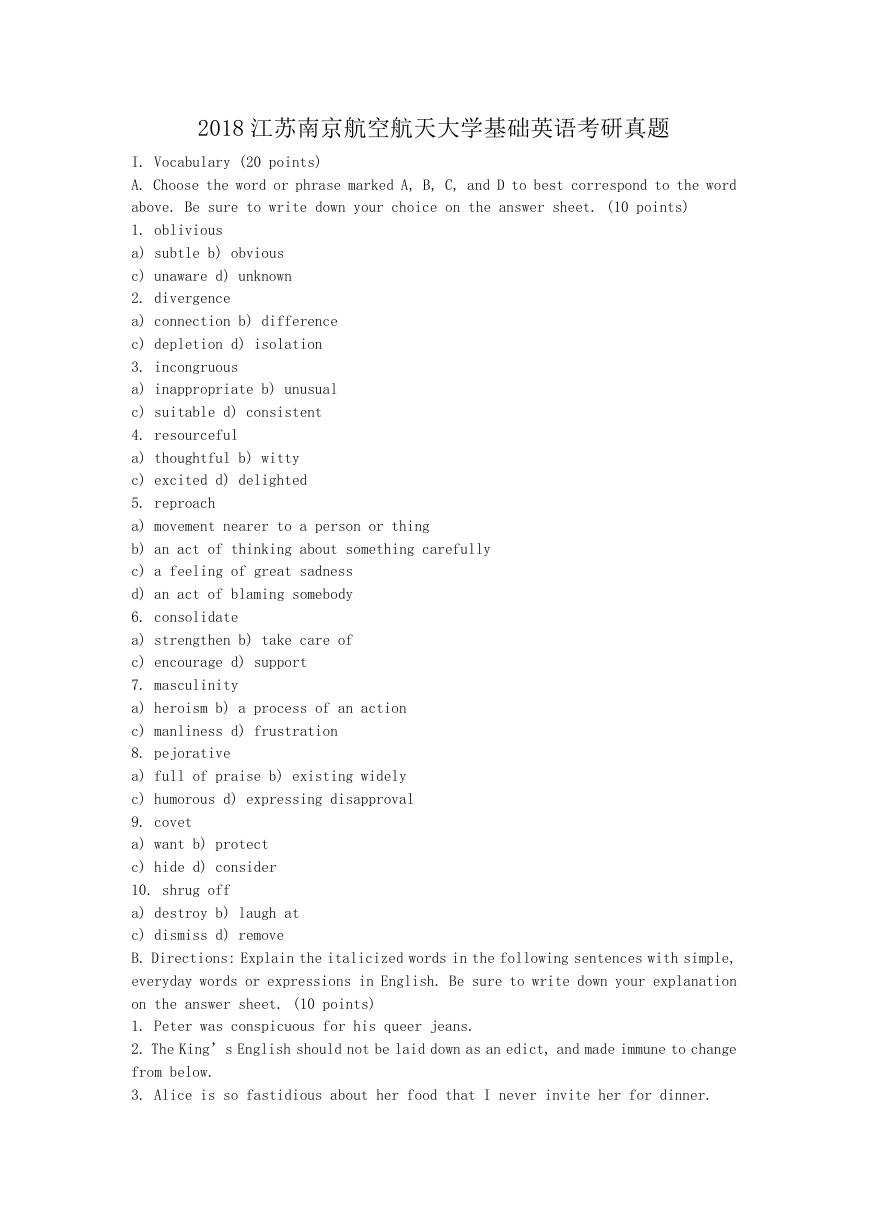
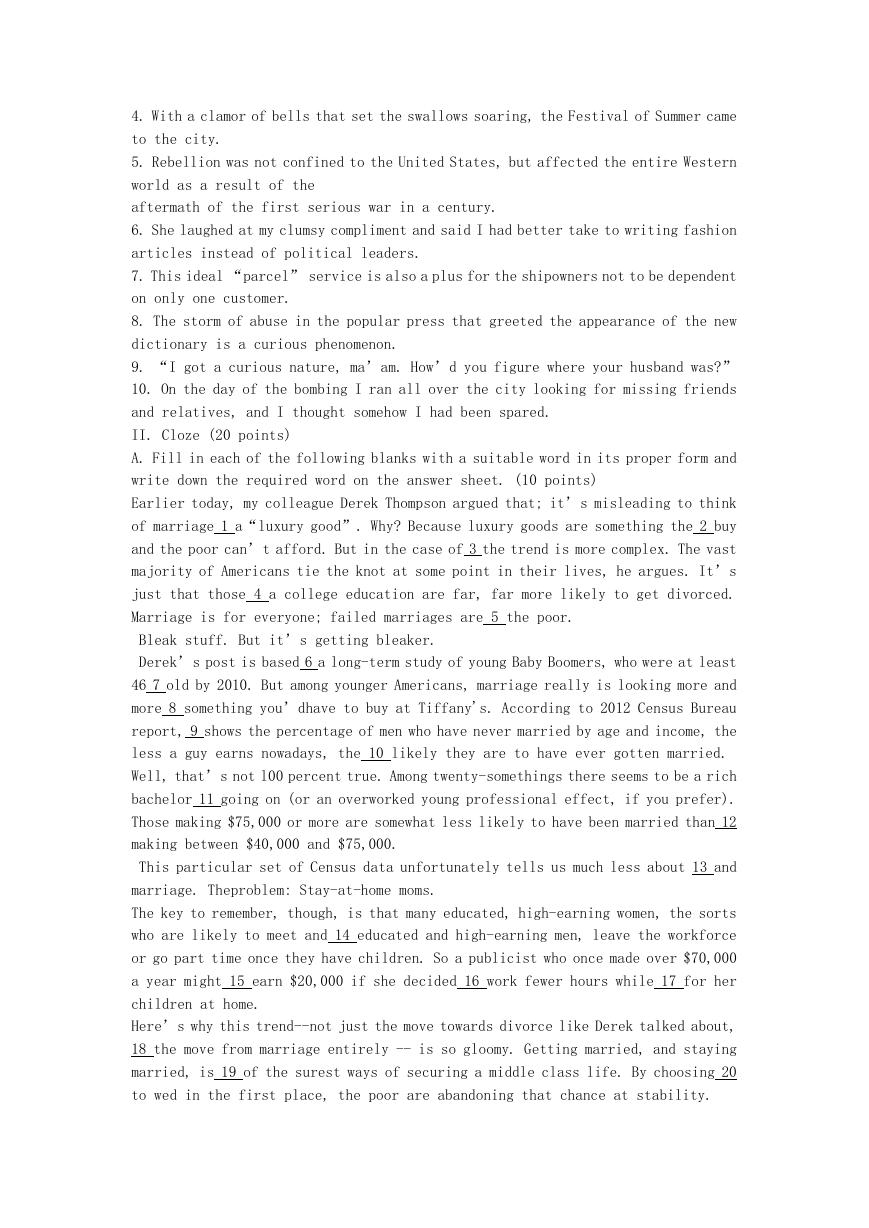
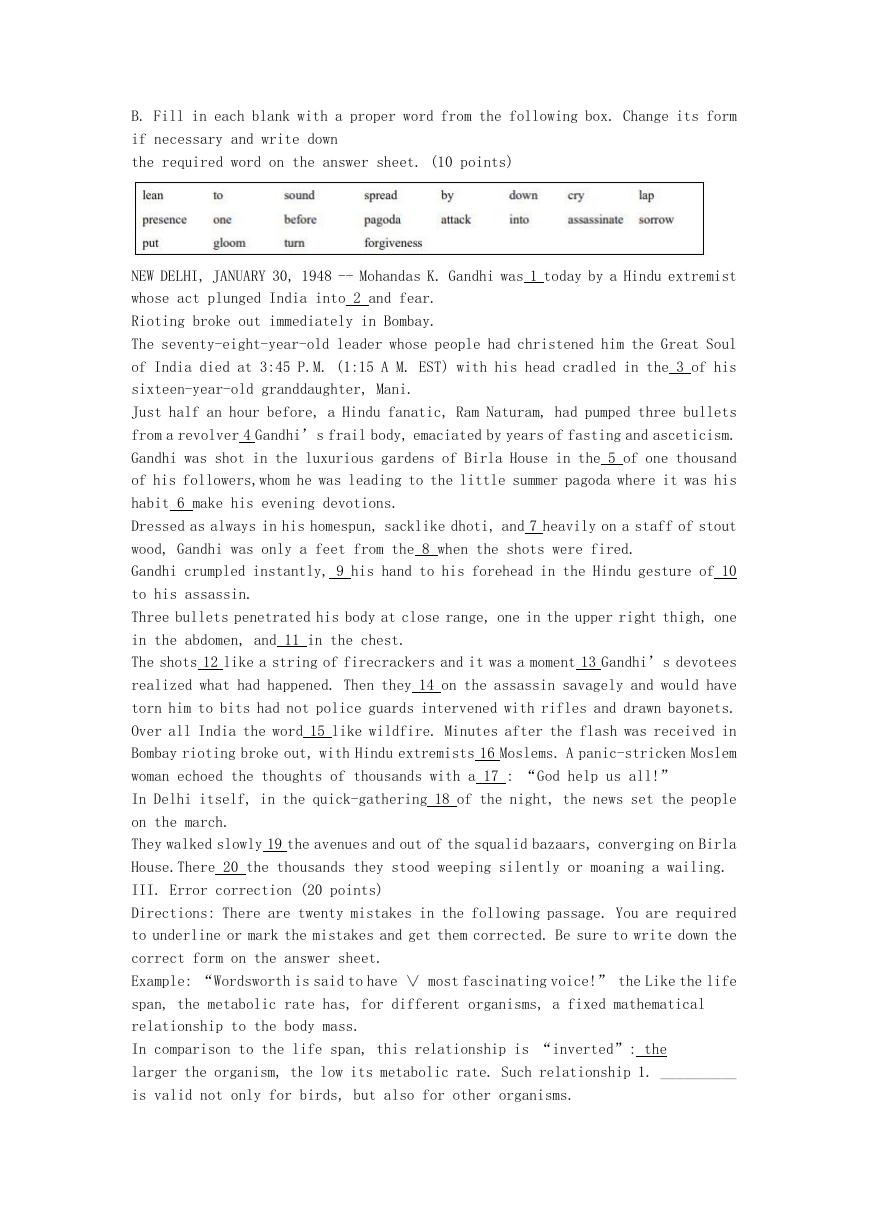
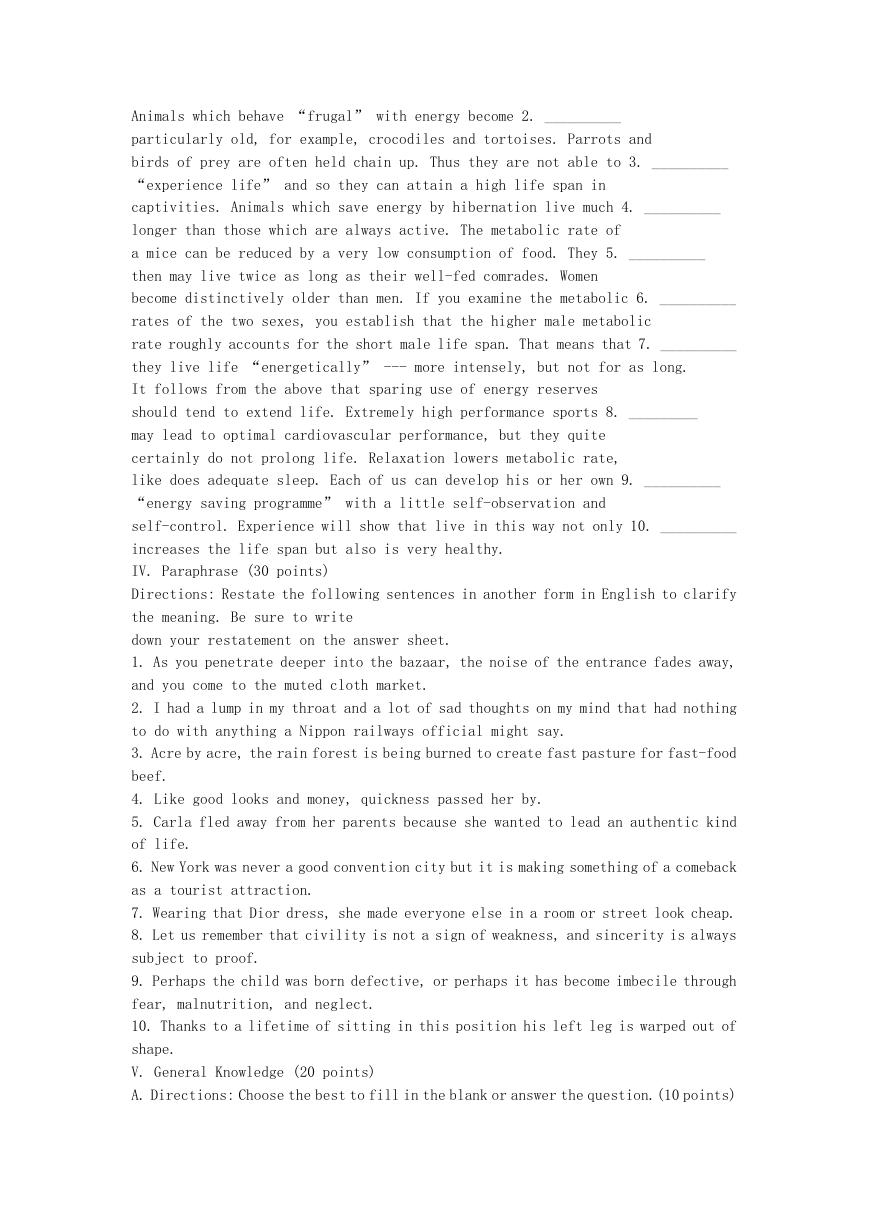
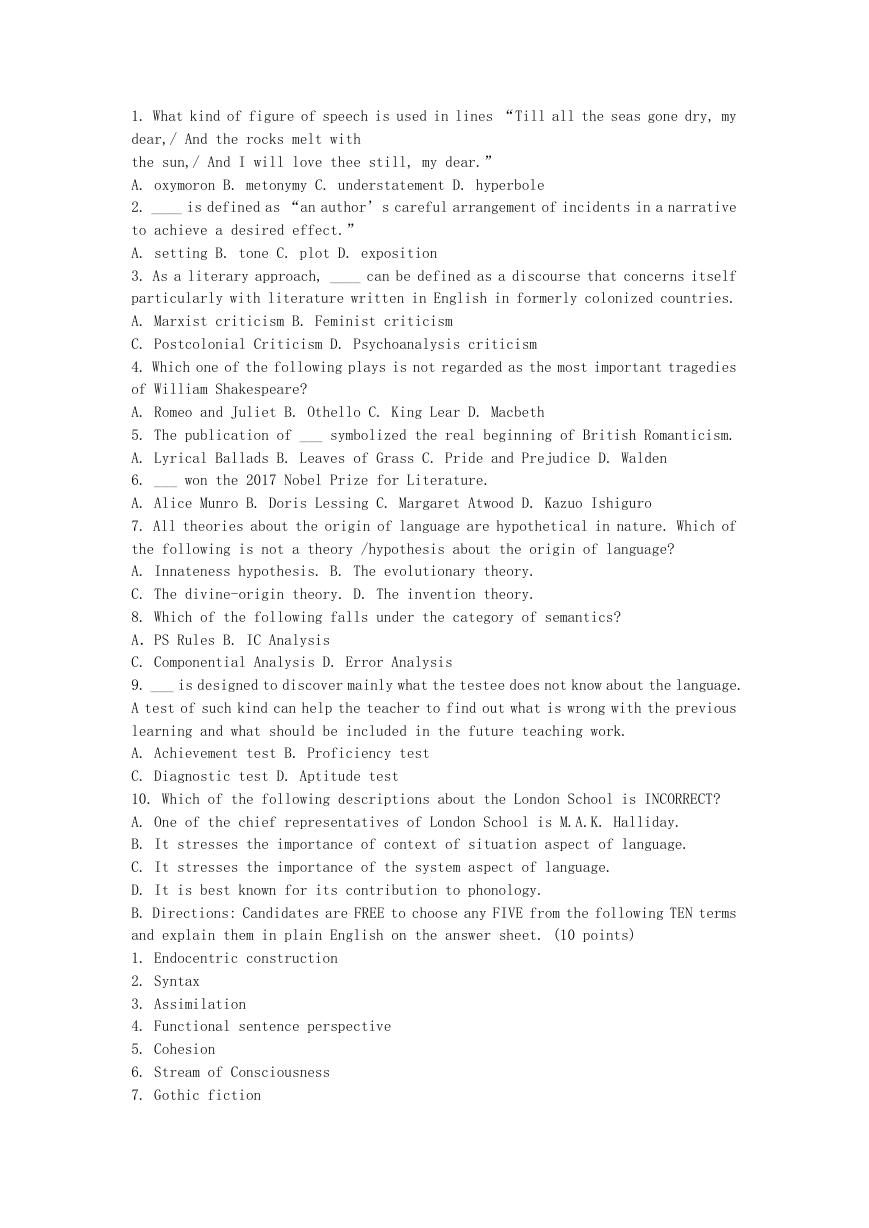
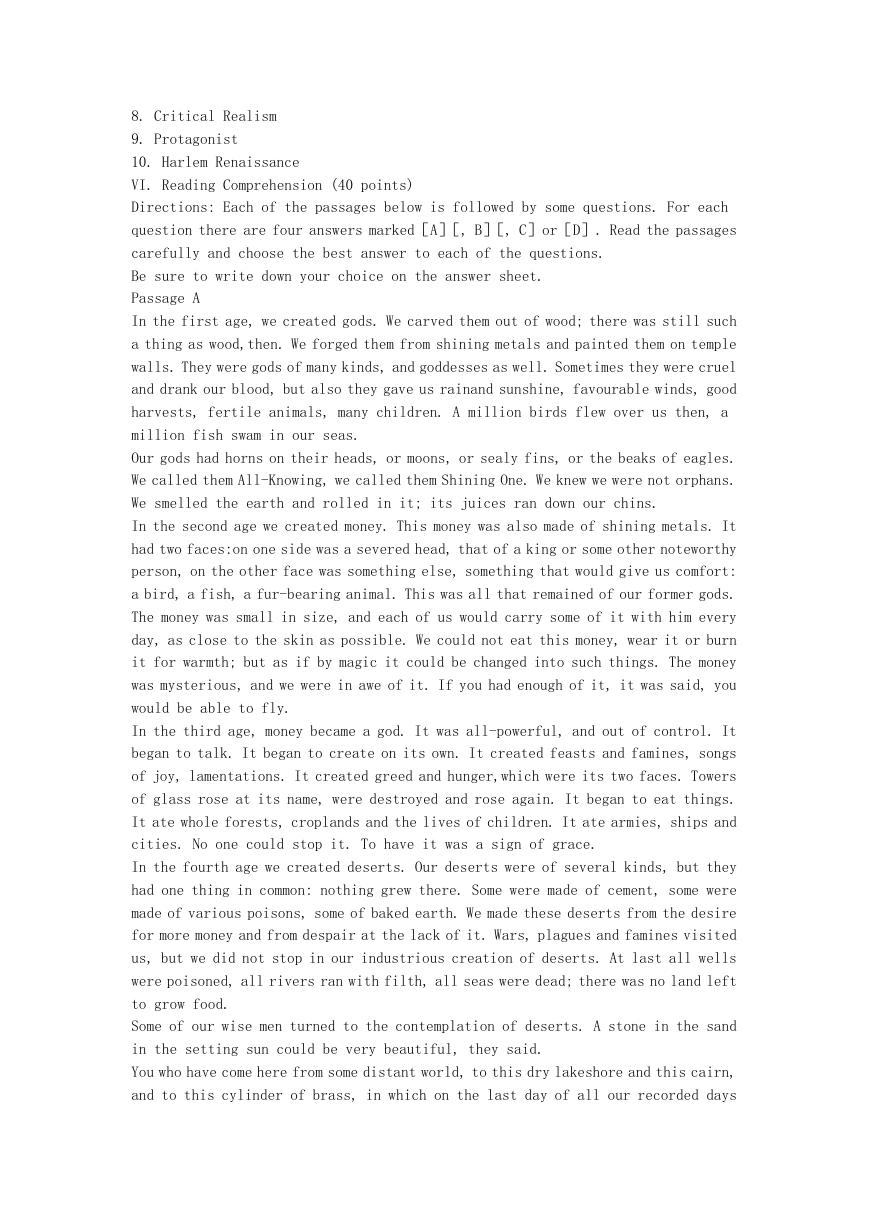
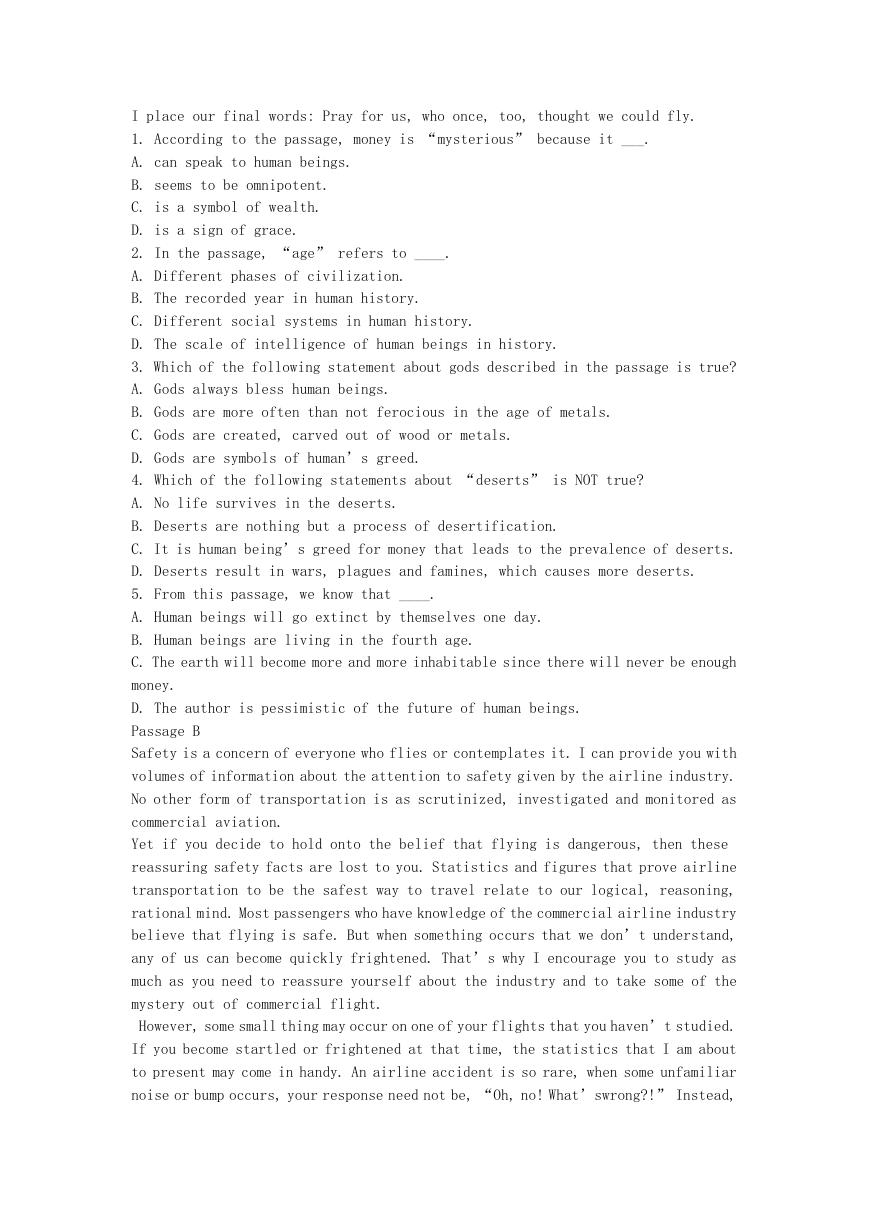
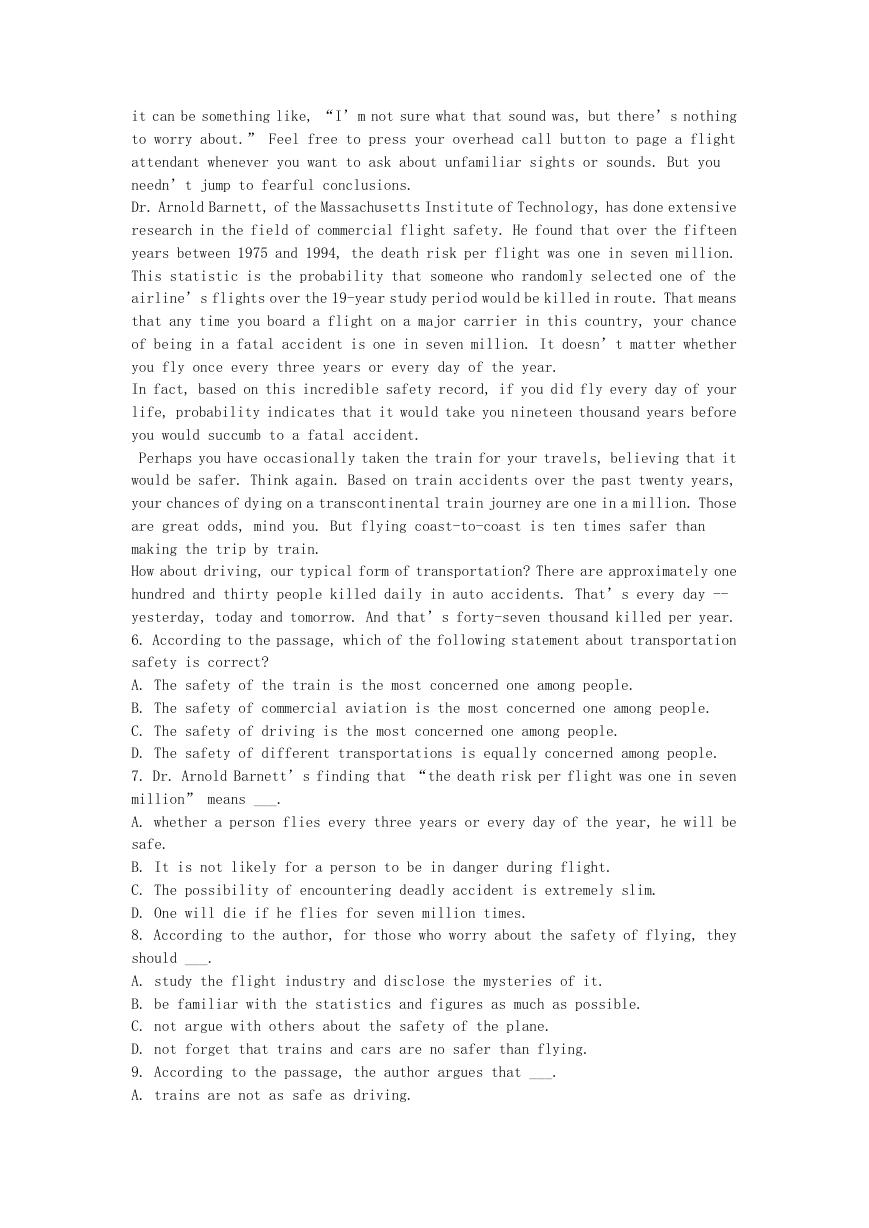








 2023年江西萍乡中考道德与法治真题及答案.doc
2023年江西萍乡中考道德与法治真题及答案.doc 2012年重庆南川中考生物真题及答案.doc
2012年重庆南川中考生物真题及答案.doc 2013年江西师范大学地理学综合及文艺理论基础考研真题.doc
2013年江西师范大学地理学综合及文艺理论基础考研真题.doc 2020年四川甘孜小升初语文真题及答案I卷.doc
2020年四川甘孜小升初语文真题及答案I卷.doc 2020年注册岩土工程师专业基础考试真题及答案.doc
2020年注册岩土工程师专业基础考试真题及答案.doc 2023-2024学年福建省厦门市九年级上学期数学月考试题及答案.doc
2023-2024学年福建省厦门市九年级上学期数学月考试题及答案.doc 2021-2022学年辽宁省沈阳市大东区九年级上学期语文期末试题及答案.doc
2021-2022学年辽宁省沈阳市大东区九年级上学期语文期末试题及答案.doc 2022-2023学年北京东城区初三第一学期物理期末试卷及答案.doc
2022-2023学年北京东城区初三第一学期物理期末试卷及答案.doc 2018上半年江西教师资格初中地理学科知识与教学能力真题及答案.doc
2018上半年江西教师资格初中地理学科知识与教学能力真题及答案.doc 2012年河北国家公务员申论考试真题及答案-省级.doc
2012年河北国家公务员申论考试真题及答案-省级.doc 2020-2021学年江苏省扬州市江都区邵樊片九年级上学期数学第一次质量检测试题及答案.doc
2020-2021学年江苏省扬州市江都区邵樊片九年级上学期数学第一次质量检测试题及答案.doc 2022下半年黑龙江教师资格证中学综合素质真题及答案.doc
2022下半年黑龙江教师资格证中学综合素质真题及答案.doc